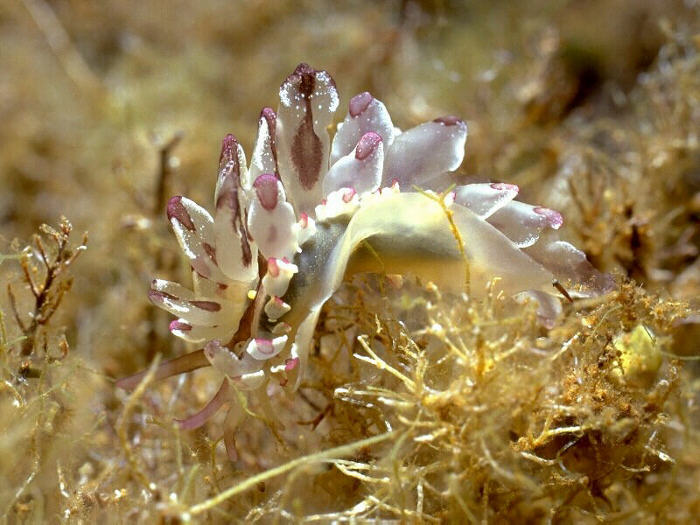 |
Cyerce cristalina
Photo courtesy of Wolfgang SeifarthVolcano Island Aeolian Islands Archipelago, Italy
Aug. 2001
Cyerce cristalina ( (Trinchese, 1881).
Oops... the identification of this Weeks BOW slipped by us. I had originally thought Wolfgang's photograph was the blue phase of Janolus cristata , with regenerating cerata along the body margin, but persons sharper than I have pointed out that the species is actually the sacoglossid nudibranch, Cyerce cristalina (Trinchese, 1881).
Externally these two completely different species, having similarly colored cerata, can be confused if you do not look at the rhinophores carefully. Note the bifurcated rhinophores in Wolfgang's photo above, and compare them to those in the photo of the yellow specimen, linked above, which are smooth and conical. Note also the eye spot in Cyerce, above.
While Janolus feeds on bryozoans, Cyerce feeds on filamentous algae.
Sorry for the mistake in identification. Thanks to Angel Valdes for
pointing this oversight out to us.
Danville, CA
Oct. 2001

| Wolfgang Seifarth is a molecular biologist working in the field of human cancer research. He lives near Heidelberg in Germany and has been diving for about 9 years. Whenever time allows, Wolfgang is heading down to the Mediterranean Sea which - he says - is very special in its marine life. "It may not directly compete with the indopacific reefs but it combines numerous cirumtropic and boreal faunistic elements making up a very unique diversity of marine life". One of Wolfgang's favourite photography subjects are polyclad flatworms, a group of large, most colorful free-living marine platyhelminths, because as he says, most divers are familiar only with the colorful nudibranchs and, therefore, polyclads are often mistaken for nudibranchs. In addition, it is very interesting to see that divergent phyla such as molluscs (nudibranchia) and platyhelminths (Turbellaria, polycladida) have evolved similar survival strategies such as feeding or defending mechanisms. |
Wolfgang is webmaster of a web site called Marine Flatworms of the World! and he hopes that collecting images and data about their occurrence, taxonomy and biology these pages may contribute to the scientific understanding of these colorful marine invertebrates.
Have a polyclad image you like to share?
Send Wolgang email at seifarth@rumms.uni-mannheim.de
Webmaster's Notes: Actually Wolfgang is quite modest in his mention of the flatworm site. In my estimation it is outstanding and well worth your time visiting and bookmarking the link! I too encourage all you branchers who are encountering polyclads in the quest for sea slugs to take the time and drop your images to Wolfgang!
Taxonomic information courtesy of Dave Behrens

David W. Behrens
Author:
Pacific Coast Nudibranchs |
